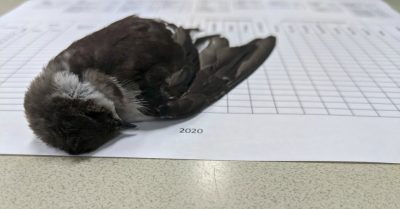‘Ecological Disaster on Massive Scale’: Hundreds of Thousands of Dead Migratory Birds in Southwest Linked to Wildfires, Climate Crisis
"The fact that we're finding hundreds of these birds dying, just kind of falling out of the sky is extremely alarming."

A combination of factors—all related to the climate crisis—is believed to be behind one of the largest mass bird die-off events in recent memory in the Southwest, according to biologists.
Scientists say thousands of dead migratory birds have been found across states including New Mexico, Texas, and Colorado in recent weeks as the American West faces wildfires that have burned through millions of acres in matter of days.
Dr. Martha Desmond, a biology professor at New Mexico State University (NMSU), told The Guardian that the die-off, which was first detected in late August, is a “national tragedy.”
“I collected over a dozen in just a two-mile stretch in front of my house,” Desmond told the newspaper. “To see this and to be picking up these carcasses and realizing how widespread this is, is personally devastating.”
Allison Salas, a graduate student at NMSU, reported on Twitter that the university is working with the U.S. Fish and Wildlife Service (USFWS) to understand the causes of the die-off, which ornithologists have linked to smoke from the wildfires as well as a drought in the Southwest.
USFWS and NM Game & Fish have been alerted. We at NMSU are working closely with them and other local wildlife biologist to understand the cause of this mass mortality. (2/9) pic.twitter.com/eg26PfejCQ
— Allison Salas (@salasphorus) September 13, 2020
The birds seem to be in relatively good condition, except that they are extremely emaciated. They have no fat reserves and barely any muscle mass. Almost as if they have been flying until they just couldn’t fly anymore. (5/9) pic.twitter.com/tTPlDxwraf
— Allison Salas (@salasphorus) September 13, 2020
We have very little data, but suspect that the west coast fires, in combination with the local cold front we experienced last week, has altered the migration patterns of many migrants. On top of that, there is little food and water available here in the Chihuahuan Desert. (7/9) pic.twitter.com/YB2Ct0ucxx
— Allison Salas (@salasphorus) September 13, 2020
“The fact that we’re finding hundreds of these birds dying, just kind of falling out of the sky is extremely alarming,” Salas told The Guardian. “The volume of carcasses that we have found has literally given me chills.”
Researchers say the birds are mainly migratory birds—such as warblers, swallows, and flycatchers—which travel to Central and South America from Canada and Alaska each year as the weather grows colder. Resident bird species don’t appear to be affected.
Based on the large volumes of dead birds found throughout the region since August 20, when the first group was found at White Sands Missile Range in southern New Mexico, ornithologists believe thousands of birds could already be dead. Desmond told the Las Cruces Sun News that “hundreds of thousands, if not millions, of migratory birds” could be lost in the die-off.
When migrating from Canada, bird species must stop every few days to gather food, drink water, and rest. With wildfires overwhelming the West Coast, scientists say birds may have been pushed into desert areas in New Mexico—which has been suffering from a drought—where food and water sources are scarce.
Changes in the birds’ northern habitat, caused by the heating of the planet, may also have pushed the species to begin their migration earlier than usual this year, before building up fat reserves which would have helped sustain them on the journey.
“We’re kind of coming at them from all sides,” Salas told The Guardian. “If we don’t do anything to protect their habitat we’re going to lose large numbers of the populations of several species.”
Desmond told WBUR that upon arriving in the drought-stricken Southwest, “a lot of birds up north were probably caught off guard.”
Since August 20, two doctoral candidates at the University of New Mexico discovered 305 dead birds in the northern part of the state and linked the deaths to starvation. Trish Cutler, a wildlife biologist at White Sands Missile Range, told KOB, a local TV station in Albuquerque, that “a couple of hundred” dead birds were found at the weapons testing site last week, compared with the fewer than half a dozen carcasses that are found there on a weekly basis.
Dr. Andrew Farnsworth of the Cornell Lab of Ornithology told the New York Times that extremely poor air quality in the West, caused by the wildfires, is likely a contributing factor to the die-off as well.
“It’s different this year than other years,” Farnsworth told the Times. “We’ve had plenty of hot summers but very few that have had these huge-scale fires combined with heat combined with drought.”
Environmental justice advocates on social media decried the “ecological disaster” detected in the Southwest.
Reported a few times last evening on the Southwest bird die-off. This is an ecological disaster on a massive scale. As a birder, I am horrified. https://t.co/b0awViDmB8
— Watchdog Progressive (@Watchdogsniffer) September 16, 2020
The signs are everywhere – mother nature is done with us and who can blame her – https://t.co/h6op8QNagk
— Erin Brockovich (@ErinBrockovich) September 15, 2020
“The signs are everywhere,” tweeted consumer advocate Erin Brockovich. “Mother Nature is done with us, and who can blame her?”
From Common Dreams: Our work is licensed under a Creative Commons Attribution-Share Alike 3.0 License. Feel free to republish and share widely.
*
Note to readers: please click the share buttons above or below. Forward this article to your email lists. Crosspost on your blog site, internet forums. etc.
Featured image: One of the hundreds of dead birds reported throughout New Mexico over the past two weeks. (Photo: Allison Salas/New Mexico State University)

